Drugs-
- Drugsare chemicals of low molecular masses.
- They interact with macromolecular targets and produce a biological response. When the biological response is therapeutic and useful, these chemicals are calledmedicinesandare used in the diagnosis, prevention, and treatment of diseases.
- Most of the drugs used as medicines are potential poisons if taken in doses higher than those recommended.
- The use of chemicals for therapeutic effect is calledchemotherapy.
Drug-Target interaction
- In the body, proteins act as enzymes in biological reactions and also act as receptors in the body's communication system. In biological reactions, proteins as enzymes facilitate the reaction of the substrate with the reagent. When the substrate comes closer to the enzyme then it binds to the enzyme and then with the help of reagent, chemical reaction happen and then the product is formed.
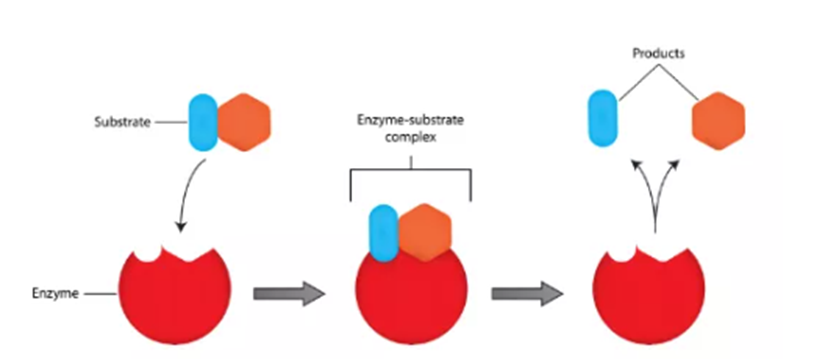
- Now, drugs inhibit this activity of the enzyme. Drugs itself bind to the active site of the enzyme and lock the space for the substrate to bind and thus the chemical reaction does not proceed. This inhibition by drugs is done two different ways:
(i) When the drug binds to the enzyme at the active site and thus no space available for the substrate and thus no chemical reaction proceeds.
(ii) When the drug binds to the enzyme at some different site also known as allosteric site, but due to this binding, the shape of the enzyme changes and thus substrate is not able to bind with the enzyme and thus no chemical reaction proceeds.
Drugs can be classified mainly on criteria outlined as follows:
- On the basis of pharmacological effectIt provides the whole range of drugs available for the treatment of a particular type of problem, e.g. analgesics have pain killer effect, antiseptics kill or arrest the growth of microorganisms.
- On the basis of drug actionIt is based on the action of a drug on the particular biochemical process, e.g. antimicrobials, neurologically active drugs, etc.
- On the basis of chemical structureDrugs classified in this way share common
structural features and often have similar pharmacological activity, e.g. sulpha drugs, arsenic drugs. - On the basis of molecular targetsDrugs are classified on the basis of their
interaction with biomolecules such as carbohydrates, lipids, proteins and nucleic acids. - Drugs which can block the binding site of the enzyme and prevent the binding of substrate or can inhibit the catalytic activity of the enzyme are called enzyme inhibitors.
- Drugs which can compete with the natural substrate for their attachment on the active sites of enzymes are called competitive inhibitors.
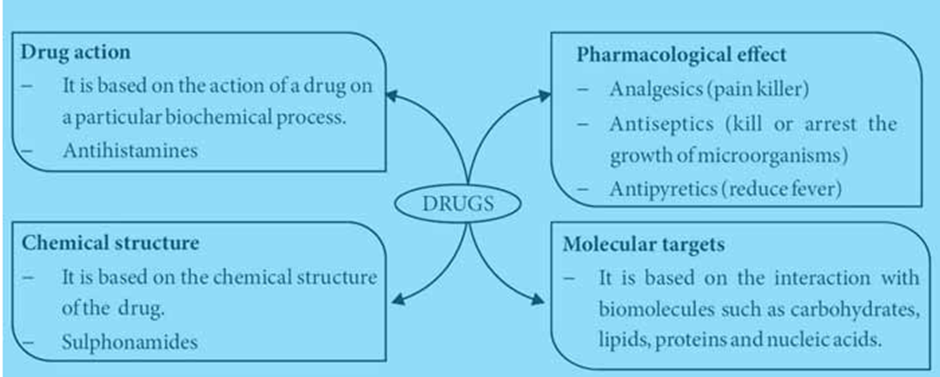
Pharmacological Classification of Drugs
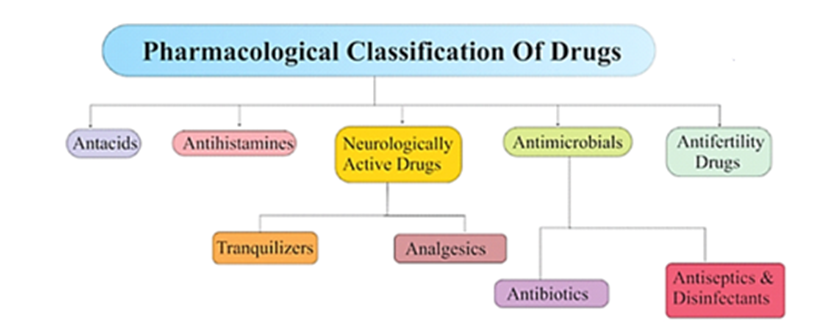
Antacid-
- Chemical substances which neutralize excess acid in the gastric juices and give relief from acid indigestion, acidity, heart burns and gastric ulcers. Examples: Eno, gelusil, digene etc.
- Antacids contain weakly basic chemicals such as magnesium hydroxide i.e. Mg(OH)2, Aluminium hydroxide i.e. Al(Cl)3, magnesium carbonate i.e. MgCO3, etc.
- One of the most popular antacid tablets is ‘Ranitidine’
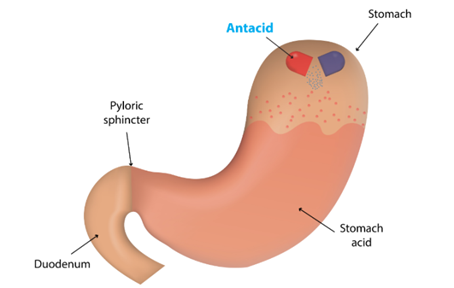
Antihistamines:
- Chemical substances which diminish or abolish the effects of histamine released in body and hence prevent allergic reactions. .
- Histamine can causeitching,sneezing,runny nose, and watery eyes.
- Examples: Brompheniramine (Dimetapp) and terfenadine (Seldane).
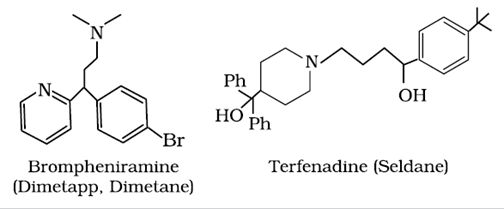
Neurologically Active Drugs: Drugs which have a neurological effect i.e. affects the message transfer mechanism from nerve to receptor.
Tranquilizers:
Chemical substances used for the treatment of stress, anxiety, irritability and mild or even severe mental diseases, are known as tranquilizers. These affect the central nervous system and induce sleep for the patients as well as eliminate the symptoms of emotional distress. They are the common constituents of sleeping pills.
Noradrenaline is one of the neurotransmitter that plays a role in mood change. If the level of noradrenaline is low, the signal sending activity becomes low, and the person suffers from depression. In such situations antidepressant drugs are required. These drugs inhibit the enzymes which catalyse the degradation of noradrenaline. If the enzyme is inhibited, this important neurotransmitter is slowly metabolized and can activate its receptor for longer periods of time, thus counteracting the effect of depression. Iproniazid and phenelzine are two such drugs.
Barbituric acid and its derivatives viz. veronal, amytal, nembutal, luminal, seconal are known as barbiturates. Barbiturates are hypnotic, i.e., sleep producing agents.
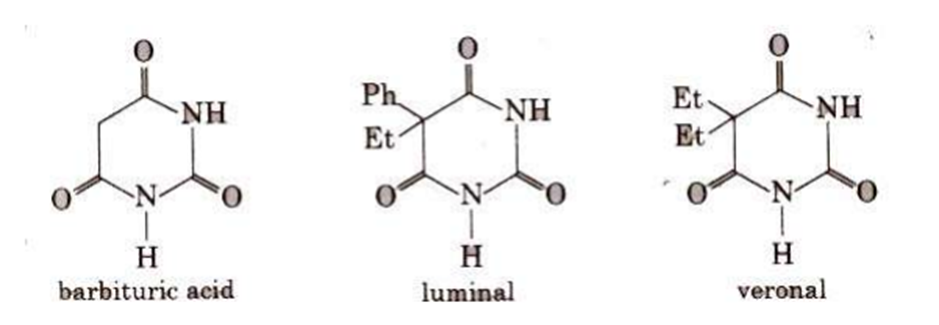
Equanil is used to control depression and hypertension.
Non-hypnotic chlorodiazepoxide and meprobamate are relatively mild tranquilizers suitable for relieving tension.
Analgesics:
- Chemical substances used to relieve pain without causing any disturbances in the nervous system like impairment of consciousness, mental confusion, in coordination or paralysis etc.
- These are also called as pain killers or pain relievers.
- Examples : aspirin, novalgin, analgin, etc.

Aspirin is toxic for liver and sometimes also causes bleeding from- stomach. So, naproxen, ibuprofen, paracetamol,dichlorofenac sodium are other widely used analgesics.
Classification of Analgesics:
- Non-narcotic analgesics:
These are non-habit forming chemicals which reduce mild to moderate llatn such as headache, toothache, muscle and joint pain, etc. These are also termed as non-addicti,ve. These drugs do not produce sleep unconsciousness. Aspirin (2-acetoxybenzoic acid) is most commonly used analgesic with antipyretic properties. Now these days because its anti-blood clotting action, aspirin is widely used to heart-attacks.
- Narcotic analgesics:
Drugs which produce sleep and unconsciousness are called narcotics. these are habit forming drugs. For example, morphine and codeine. Morphine diacetate is commonly known as heroin.
Antipyretics
These are the chemical substance which reduce body temperature during high fever. Paracetamol, aspirin, phenacetin (4-hydroxy acetanilide), analgin and novalgin, etc., are common antipyretics. Out of these, paracetamol (4-acetamidophenol) is most common.
Anti-fertility Drugs: Chemical substances used to prevent conception or fertilization are called anti-fertility drugs. Examples – Norethindrone, ethynylestradiol (novestrol).
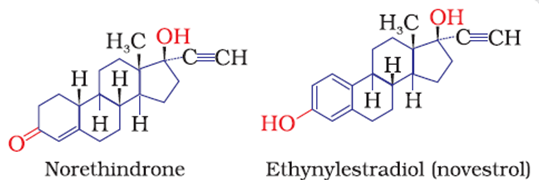
Anti-microbials: Drugs that tends to destroy/prevent development or inhibit the pathogenic action of microbes such as bacteria (antibacterial drugs), fungi (anti-fungal agents), virus (antiviral agents), or other parasites (anti-parasitic drugs) selectively. The drug used to prevent the pathogenicity of microorganism is called an antimicrobial agent.
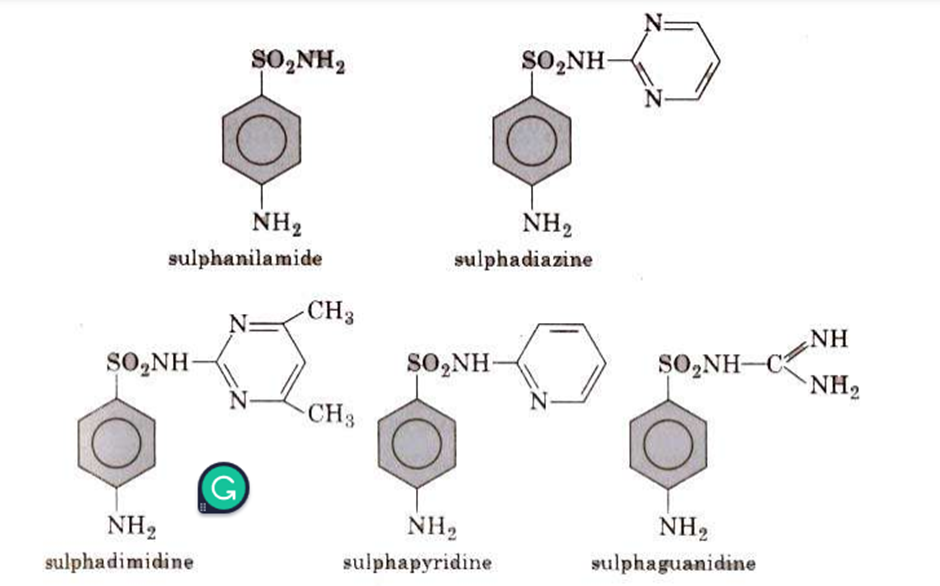
Types of antimicrobial drugs :
Antiseptics:
These are the chemicals which either kill or prevent the growth microorganisms. Antiseptics are applied to the living tissues such wounds, cuts, ulcers and skin diseases in the form of antiseptic creams like furacin and soframycin. e.g., Some important examples of antiseptics are
(i) Dettol is a mixture of chloroxylenol and terpineol.
(ii) Bithional is added to soaps to impart antiseptic properties to reduce the odours produced by bacterial organic matter on the skin.
(iii) Tincture of iodine is a 2-3% solution of iodine in alcohol, which is a powerful antiseptic for wounds.
(iv) Iodoform is also used as an antiseptic for wounds
Disinfectants:
These are the chemical substances which kill microorganisms not safe to be applied to the living tissues. They are generally kill the microorganisms present on inanimate objects such as drainage systems, instruments, etc.
Some common examples of disinfectants are as follows :
(i) 1% phenol solution is disinfectant while in lower concentration 0.2% solution of phenol is antiseptic.
(ii) 0.2-0.4 ppm aqueous solution of chlorine is used for sterilisation of water to make it fit for drinking purpose.
(iii) SO2 at very low concentrations behaves like disinfectant.
(iv) Formaldehyde (HCHO) in the disinfecting rooms and operation gaseous theatres forms is used in hospitals.
Antibiotics: Chemical substances produced by microorganisms that kill or prevent the growth of other microbes.
Antibiotics are of two types :
Bactericidal antibiotics have cidal (killing) effect on microbes. For example, penicillin, ofloxacin, amino glycosides, etc.
Bacteriostatic antibiotics have a static (inhibitory) effect on microbes. For example, erythromycin, tetracycline, chloramphenicol, etc
Penicillin was the first antibiotic discovered (by Alexander Fleming) in 1929. It is a narrowspectrum antibiotic. Ampicillin and amoxicillin are semi-synthetic Illodifications of penicillin.
Penicillin is not suitable to all persons and some Personsare allergic to it. Consequently, it is essential to test the patients for sensitivity (or allergy) to penicillin, before it is administered
In India, penicillin is manufactured at Pimpri and Rishikesh (Uttarakhand).
Broad-spectrum antibiotics also called antibiotics, are antibiotics which are effective against different types of harmful microorganisms. e.g., Tetracycline, chloramphenicoltgiven in case of typhoid, dysentery, fever ofloxacin, etc.
Classification of antimicrobial drugs based on the mode of control of microbial diseases:
- Bactericidal drugs – Drugs that kills organisms in the body. Examples – Penicillin, Aminoglycosides, Ofloxacin.
- Bacteriostatic drugs – Drugs that inhibits growth of organisms. Examples – Erythromycin, Tetracycline, Chloramphenicol.
Classification of antimicrobial drugs based on its spectrum of action:
- Broad-spectrum antibiotics – Antibiotics which kill or inhibit a wide range of Gram-positive and Gram-negative bacteria are called broad-spectrum antibiotics. Examples – Ampicillin and Amoxycillin.
- Narrow spectrum antibiotics – Antibiotics which are effective mainly against Gram-positive or Gram-negative bacteria are called narrow-spectrum antibiotics. Examples- Penicillin G.
- Limited spectrum antibiotics - Antibiotics effective against a single organism or disease.
|
Drugs |
Description |
Examples |
|
Analgesics |
Relieve or decreases the pain without causing unconsciousness. These are also known as “Pain Killers”. |
Asprin, Analgin, seridon etc. |
|
Tranquizers/ Antidepressants |
These are used for treatment of mental diseases. |
Equanil, Calmpose, Tofranil, Barbituric Acid, Cocaine and Iproniazids etc.. |
|
Antiseptics |
They are applied on living tissues to kill or prevent the growth of micro-organisms. |
Dettol, Savlon and Acriflavin etc. |
|
Disinfectants |
These are applied on floor, instruments or wall etc. to kill microorganisms but are not safe for application on living tissues. |
Phenol |
|
Antimicrobial |
These are use to either kill (bactericidal) or stop the growth of diseases causing microorganisms. (bacteriostatic). |
Salvarsan, Prontosil, Sulphanilamide, Bacteriostatic Drugs: Erythromycin, Tetracycline, Chloramphenicol Bactericidal Drugs: Ofloxacin, Aminoglycosides. |
|
Antipyretics |
These drugs bring down the body temperature during fever. |
Paracetamol, Analgin and Novalgin. |
|
Antifertility Drugs |
Prevent pregnancy in women by controlling menstrual cycle and ovulation. |
Norethindrone & Mestranol |
|
Antacids |
Used for the treatment of acidity. Metal hydroxides are generally used as antacids. |
Eno, & Milk of magnesia [Mg(OH)2] |
|
Antibiotics |
These are the chemical substances which are produced by micro –organisms like bacteria and fungi and are able to kill or stop the growth of pathogenic microorganisms. |
Penicillin, Amoxicillin and Ampicillin. |
|
Antihistamins |
These drugs compete with histamine for finding sites of receptors and thus interfere with the natural action of histamine. |
Brompheniramine & Terfenadine |